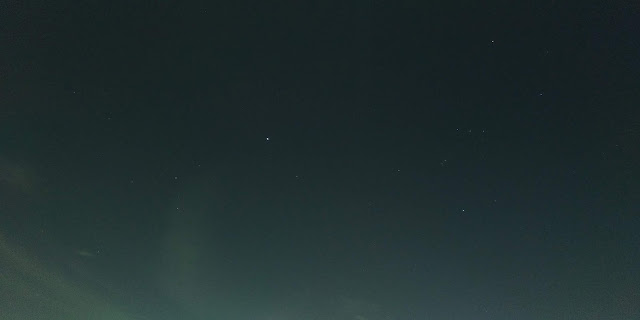Stargazing - Orion And Canis Major Constellation In Night Sky (April 2, 2020 - Ghaziabad, India)
Photo with higher resolution and clarity can be found here. The photo was taken on April 2, 2020 from Ghaziabad (Delhi NCR), India at around 7-8 PM IST. Canis Major and Orion Constellation are easily visible in the photo (Open the original photo in full size to see other fainter objects as well).
In the edited photo below, labels are added for various visible celestial objects:
Objects a, b, c, d, e, f, g, h, i and j are part of Orion constellation (‘The Hunter’). Objects c, d, e form the belt of Orion while objects f, g, h form the sword of Orion.
- Object a – Betelgeuse - Tenth-brightest star in the night sky and the second-brightest in the constellation of Orion. Currently a red supergiant of spectral type M1-2. One of the largest stars visible to the naked eye. Apparent magnitude vary between +0.0 and +1.6. Mass approx. 10-20 times that of Sun and located nearly 700 light-years from it. It is expected to blow up in a supernova explosion within 100,000 years.
- Object b – Bellatrix - Third-brightest star in the constellation of Orion. Variable magnitude of around 1.6. About 8.6 times the Sun's mass and 250 light years away. Was also called the Amazon Star.
- Object c – Alnitak - Triple star system about 225 parsecs away. The primary star, Alnitak Aa, is a hot blue supergiant with an absolute magnitude of -6.0 and is the brightest class O star in the night sky with a visual magnitude of +2.0. It has two bluish 4th magnitude companions, one finely resolved and one only detected interferometrically and spectroscopically, producing a combined magnitude for the trio of +1.77. Alnitak Aa is 33 times massive, 20 times greater in diameter, and 21,000 times brighter than the Sun.
- Object d – Alnilam - Large blue supergiant star some 2,000 light-years away. It is estimated to be 275,000 to 832,000 times as luminous as the Sun, and 30–64.5 times as massive. Magnitude: 1.64 to 1.74.
- Object e – Mintaka - Multiple star system some 1,200 light-years from the Sun. There is a magnitude 7 star about 52 arcseconds away from the second-magnitude primary and a much fainter star in between. The primary component is itself a triple system: a class O9.5 bright giant and a class B main sequence star orbit every 5.73 days and exhibit shallow eclipses when the star dims about 0.2 magnitudes and a B-class sub-giant is resolved 0.26" away. The seventh magnitude companion, HD 36485, is a chemically peculiar B-type main sequence star and itself a spectroscopic binary with a faint A-type companion in a 30-day orbit.
- Object f - 42 Orionis - A class B1V (blue main-sequence) star. Apparent magnitude is 4.59 and it is approximately 900 light years away.
- Object g - Orion Nebula and Trapezium Cluster – The Orion Nebula (M42 or NGC 1976) is a diffuse nebula situated in the Milky Way. It is one of the brightest nebulae, and is visible to the naked eye in the night sky. Located at a distance of 1,344 ± 20 light years, it is the closest region of massive star formation to Earth. The M42 nebula is estimated to be 24 light years across. It has a mass of about 2,000 times that of the Sun. The Orion Nebula contains a very young open cluster at its heart, known as the Trapezium due to the asterism of its primary four stars.
- Object h - Iota Orionis - A multiple star system with apparent visual magnitude of 2.77 located 2,300 light-years from the Sun. Member of the NGC 1980 open cluster.
- Object i – Saiph - A supergiant with a stellar classification of B0.5 Ia. 650 light years away and with an apparent visual magnitude of 2.1.
- Object j – Rigel – Brightest star in Orion constellation and 7th brightest in the overall night sky. A star system containing at least four stars, the primary star of which (either Rigel A or simply Rigel) is a massive blue supergiant of spectral type B8Ia. It is calculated to be anywhere from 61,500 to 363,000 times as luminous and 18 to 24 times as massive as the Sun. Located 860 light years away. Rigel (A) has a companion 9.5 arc seconds away with an apparent magnitude of 6.7, or 1/400th as bright. Often referred to as Rigel B or Rigel BC, this companion is actually a triple star system. Two stars, components B and C, can be resolved by very large telescopes. The brighter of the two is a spectroscopic binary, the components designated Ba and Bb. These three stars are blue-white main sequence stars each around three to four times as massive as the Sun. Rigel A and Rigel BC—around 2,200 astronomical units distant from each other—are thought to orbit around a common centre of gravity every 24,000 years. Rigel B and C orbit around each other every 63 years and Rigel Ba and Bb every 10 days. A fainter star, separated from the others by nearly an arc minute, might be part of the same star system.
- Object k – Sirius - The brightest star in the night sky. Visual apparent magnitude of -1.46. A binary star consisting of a main-sequence star of spectral type A0 or A1, termed Sirius A, and a faint white dwarf companion of spectral type DA2, termed Sirius B. The distance between the two varies between 8.2 and 31.5 astronomical units as they orbit every 50 years. Reason for its high brightness is its high intrinsic luminosity as well as proximity to solar system (located at just 8.6 light years away). Sirius is gradually moving closer to the Solar System, so it will slightly increase in brightness over the next 60,000 years. Sirius A is about twice as massive and 25 times more luminous than the Sun. Sirius is known colloquially as the "Dog Star", reflecting its prominence in its constellation, Canis Major.
- Object l - Omicron2 Canis Majoris - Apparent visual magnitude of 3.043. The distance to this star is roughly 2,800 light years (800 parsecs), with a 34% margin of error. A massive supergiant star with a stellar classification of B3 Ia. It has about 21 times the mass of the Sun and 65 times the Sun's radius. Omicron2 Canis Majoris is one of the most luminous stars known, as it radiates about 220,000 times as much luminosity as the Sun from its outer envelope at a temperature of 15,500 K.
- Object m - Omicron1 Canis Majoris - A red K-type supergiant with apparent magnitudes between 3.78 and 3.99. It is a cool star as its surface temperature is around 3,900 K. Around 8 times as massive as the Sun with around 280 times its diameter, it shines with 16,000 times its luminosity.
- Object n – Wezen - A yellow-white F-type supergiant with an apparent magnitude of +1.83. Radius is around 215 times that of the Sun. Its surface temperature is around 5,818 K, and it is 17 times more massive than the Sun. It lies around 1,600 light-years away.
- Object o – Aludra – Even after being 2000 light years away, it is easily visible because of it being intrinsically many times brighter than the Sun. A blue-white supergiant of spectral type B5Ia, Aludra has a luminosity 176,000 times and a diameter around 80 times that of the Sun. Mass is 19.19 times that of the Sun.
- Object p – Unurgunite - A supergiant star with a stellar classification of K4 III, approximately 1,120 light-years (340 parsecs) from the Sun and has an average apparent visual magnitude of +3.41. Having consumed the hydrogen at its core, it has ballooned out to 420 times the Sun's radius. At 1.95 Astronomical units, this radius is nearly double the average distance of the Earth from the Sun. It is currently radiating about 32,000 times the luminosity of the Sun from its outer envelope at an effective temperature of around 3,877 K.
- Object q – Adhara - A binary star. The second-brightest object in the constellation of Canis Major and one of the brightest stars in the night sky with an apparent magnitude of 1.50. It is about 430 light-years distant from the Sun. The primary, e Canis Majoris A, has an apparent magnitude of +1.5 and belongs to the spectral classification B2. Its color is blue or blueish-white, due to the surface temperature of 22,200K. It emits a total radiation equal to 38,700 times that of the Sun. This star is the brightest extreme ultraviolet source in the night sky. It is the strongest source of photons capable of ionizing hydrogen atoms in interstellar gas near the Sun, and is very important in determining the ionization state of the Local Interstellar Cloud. The +7.5-magnitude (the absolute magnitude amounts to +1.9) companion star, e Canis Majoris B, is 7.5" away with a position angle of 161° of the main star. Few million years ago, e Canis Majoris was much closer to the Sun than it is at present, causing it to be a much brighter star in the night sky. About 4.7 million years ago, Adhara was 34 light-years from the Sun, and was the brightest star in the sky with a magnitude of –3.99. No other star has attained this brightness since, nor will any other star attain this brightness for at least five million years.
- Object r – Mirzam – About 500 light-years (150 parsecs) from the Sun. A Beta Cephei variable that varies in apparent magnitude between +1.97 and +2.01 over a six-hour period. It exhibits this variation in luminosity because of periodic pulsations in its outer envelope, which follow a complex pattern with three different cycles. Mass of about 13–14 times the mass of the Sun with 8–11 times the Sun's radius. The effective temperature of the star's outer envelope is about 23,150 K.
We hope you like this post. Share your thoughts, feedback and queries in the comments. You can contact us here for anything important.





Comments
Post a Comment